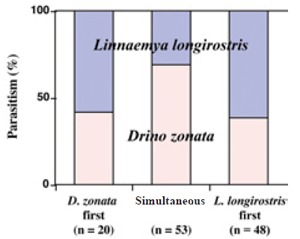Seasonal occurrence and natural enemies of Helicoverpa armigera (Lepidoptera: Noctuidae) larvae on pigeon pea in Kenya
Description
In view of the recent interest in the use of sustainable and environmentally friendly methods to control crop pests, there is an increasing focus on using indigenous natural enemies to achive biological control.
Helicoverpa armigera is one of most serious pests of vegetables, cereals, and cash crops worldwide. Based on our several field surveys in Kenya, this species is also abundant in the fields, but is attacked by various natural enemies, including several species of parasitoids. We established an experimental field of pigeon pea (Cajanus cajan) at Nairobi in Kenya and conducted weekly collections of H. armigera larvae in order to obtain information on the pest and the occurrence of its natural enemies throughout the year. Collected larvae were kept individually, provided with an artificial diet, and observed for development and parasitization. Data on seasonal occurrence, percentage parasitism, and the host's stage when attacked were compiled between February 2002 and September 2004.
Our results showed the most important mortality factor of the collected H. armigera larvae to be parasitization by the gregarious Drino zonata and the solitary Linnaemya longirostris, both of which are parasitoid flies in the Tachinid family (Figs. 1 and 2). Parasitization of the two species peaked at different times of the year. Total parasitism per month and per week sometimes exceeded 50% (Fig. 1) and 75%, respectively.
Our laboratory experiments revealed that D. zonata required relatively high temperatures to develop: they could not survive at temperatures below 15°C, which might be one of the reasons for the decrease in percentage parasitism by this parasitoid between May and January (Fig. 2 (b)), as these months present minimum temperatures lower than 15°C.
Competition between the two species within a host was also investigated in the laboratory, since one species parasitized on the day-1 last instar larva of H. armigera, 48 hours before the other (clutch size was 1). We found no absolute winners in any cases or of unsuccessful parasitization, defined as both parasitoids dying within the host (Fig. 3).
Drino zonata showed high parasitization rates in early months of the year but L. longirostris showed the same rate all the year through. They did not exhibit scramble-type competition, but coexisted in the same environment. We conclude that these two parasitoid species are good potential candidates as biological control agents of H. armigera.
Figure, table
-
Fig. 1.
Monthly changes in the number of H. armigera larvae collected in the field (bars) and total percentage parasitism by the two tachinid species L. longirostris and D. zonata (line) from February 2002 to September 2004. -
Fig. 2.
Monthly changes in percentage parasitism of H. armigera by L. longirostris (a) and D. zonata (b) from February 2002 to September 2004. -
Fig. 3.
Percentage of adult emergence of tachinid flies (L. longirostris and D. zonata) when one tachinid species parasitized on the day-1 last instar larva of H. armigera, 48 hours before the other species (clutch sizes were normalized as one).
- Affiliation
-
Japan International Research Center for Agricultural Sciences Crop Production and Environment Division
- Classification
-
Technical A
- Term of research
-
FY2004(FY2002~2004)
- Responsible researcher
-
NAKAMURA Satoshi ( Crop Production and Environment Division )
- ほか
- Publication, etc.
-
Nakamura,S., Ahuya,P. and Olkohe,B. (2002): Biology and attempted establishment of Linnaemya longirostris(Diptera: Tachinidae), a parasitoid of Helicoverpa armigera(Lepidoptera: Noctuidae). First International Symposium on Biological Control of Arthropods, Honolulu, Hawaii. U.S.A., Program and Abstracts, 94-95.
Brzezowski,R., Nakamura,S. and Yoshida,T. (2004): Seasonal occurrence of parasitoids attacking Helicoverpa armigera(Lepidoptera: Noctuidae) in Kenya. Proceedings of the 22nd International Congress of Entomology, Brisbane, Australia.
Brzezowski,R., Nakamura,S. and Yoshida,T.(2004):Life history parameters of Palexorista zonata(Diptera: Tachinidae): host acceptance and suitability of three lepidopteran species. Proceedings of the 22nd International Congress of Entomology, Brisbane, Australia.
- Japanese PDF
-
2004_10_A3_ja.pdf649.55 KB



